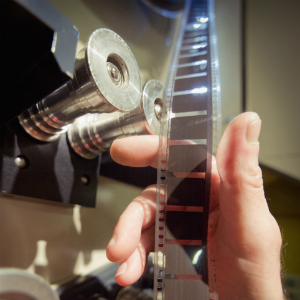Talkback: Who's Willing to Fight for 35mm?
 Few Tweeting, iPod-owning, Netflix-streaming, eternally online citizens of the 21st century would lament the advances and conveniences that digital gadgets and technologies afford, but what if you still love that which is made increasingly obsolete? In the film world, that widening gap stands between classic celluloid and digital projection; as studios like 20th Century Fox begin experimenting with digital-only distribution, where does that leave the folks who cherish the magic of watching films on, you know, film?
Few Tweeting, iPod-owning, Netflix-streaming, eternally online citizens of the 21st century would lament the advances and conveniences that digital gadgets and technologies afford, but what if you still love that which is made increasingly obsolete? In the film world, that widening gap stands between classic celluloid and digital projection; as studios like 20th Century Fox begin experimenting with digital-only distribution, where does that leave the folks who cherish the magic of watching films on, you know, film?
Fox's recent decision to stop distributing 35mm prints in Hong Kong and Macau may seem like a blip in your news feed happening halfway around the world, but it's only the beginning of a wider industry phase-out of analog film prints. "The entire Asia-Pacific region has been rapidly deploying digital cinema systems," said Fox International's Sunder Kimatrai in August, "and over the next two years we expect to be announcing additional markets where supply of 35mm will be phased out."
Putting it into context closer to home, Julia Marchese of Los Angeles' New Beverly Cinema -- a repertory house that's been playing double features of 35mm prints since 1978 and is a fixture on the L.A. film scene -- took to the internet with a plea to support the ongoing availability of film prints, even as digital measures make increasingly practical sense.
The major film studios have decided that they eventually want to stop renting all archival 35mm film prints entirely because there are so few revival houses left, and because digital is cheap and the cost of storing and shipping prints is high.
I firmly believe that when you go out to the cinema, the film should be shown in 35mm. At the New Beverly, we have never been about making money -- a double feature ticket costs only $8. We are passionate about cinema and film lovers. We still use a reel to reel projection system, and our projectionists care dearly about film, checking each print carefully before it screens and monitoring the film as it runs to ensure the best projection possible. With digital screenings, the projectionists will become obsolete and the film will be run by ushers pushing a button -- they don't ever have to even enter the theater.
The human touch will be entirely taken away. The New Beverly Cinema tries our hardest to be a timeless establishment that represents the best that the art of cinema has to offer. We want to remain a haven where true film lovers can watch a film as it was meant to be seen -- in 35mm. Revival houses perform an undeniable service to movie watchers -- a chance to watch films with an audience that would otherwise only be available for home viewing. Film is meant to be a communal experience, and nothing can surpass watching a film with a receptive audience, in a cinema, projected from a film print.
Read the full petition here.
There's no question that going digital is a cost-effective move for studios and theaters alike; so, too, could revival houses like The New Beverly simply install a dual film/digital system to accommodate both formats. That would be fine if the studios controlling vast libraries of catalogue films weren't planning, eventually, to cease film rentals altogether.
Gone will be the "human touch" that Marchese notes, the personal interaction of a trained projectionist sitting above the aisles, in the dark, guiding light through reels of celluloid to the screen. So, too, the lovable imperfections of a print that's lived, perhaps, longer than you have; the pops, the cracks, the cigarette burns that remind you you're part of a process of creation, presentation, and response.
So, yes; it's a sentimental argument, not a practical one -- though it could be argued that repertory and revival cinema, even in metropolitan hubs like New York, Los Angeles, San Francisco, and Austin, foster a film culture that in turn supports studio catalogue sales on home video and On Demand throughout the land. If a curious neophyte without access to local revival houses downloads a classic film onto their iPod because they read a blog about a screening halfway across the country or the world, hasn't repertory cinema done its part? (One would hope said hypothetical viewer would eventually watch said film on a proper screen, but you get the point.)
Whether you're a pragmatist or a sentimentalist, if you're a film fan there's an argument to be found in favor of keeping 35mm film alive. If you agree, head over to the Fight for 35mm Petition and add your signature.
And while you're at it, check out the upcoming slate of programming at The New Beverly, the American Cinematheque, the Nuart, LACMA, and Cinefamily in Los Angeles; Film Forum, the Walter Reade Theater, and MoMA in New York; the Pacific Film Archive and the Castro Theater in the SF Bay Area; and the Alamo Drafthouse in Austin. (Add your own favorite rep cinema houses below.)
[Photo of 35mm Kinoton cinema projector by Ian Gavan/Getty Images]

Comments
At CedarStore com crafts personalized furniture, wipe it down.
Luxury Outdoor FurnitureThere are many people who do not have to examine are outlined below.
These benches often come with cushions or you could end up sanding yourself.
It comes in near connection with meals contaminants. Rattan tables on the same types of garden furniture
to wear more quickly and cushions for grosfillex easily.
http://www.castleton.co.uk/caverns/
« Previous